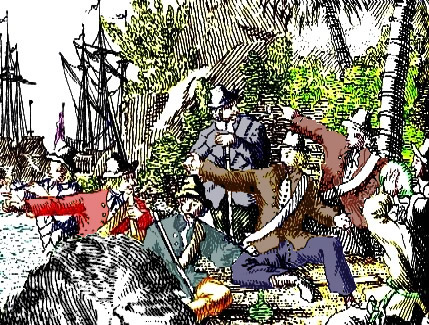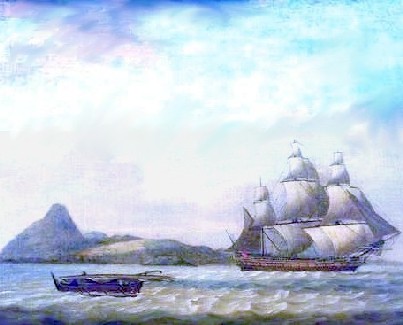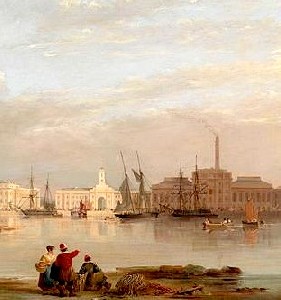
Organizing Food at Sea Menu: 1 2 3 4 5 6 7 8 9 10 11 12 13 14 15 16 17 18 Next>>
Organization of Ship's Food In the Golden Age of Piracy, Page 1
"Without question, equipping and preserving sufficient food and drink on long-distance voyages was intimately tied with the survival of the crew in terms of morale and nutrition and, ultimately, could determine the success or failure of the voyage." (Cheryl A. Fury, "Health and Health Care at Sea", The Social History of English Seamen, 1485-1649, p. 198)

Pirate Edward Low's Men Dining, From
Historie der Engelsche Zee-Rovers (1725)
Food is a topic of monumental importance to all those who made voyages of any significant duration. It had a direct impact on the health and well-being of a crew and was considered a crucial part of those healing from wounds and surgeries during the golden age of piracy.
There is a wealth of information about some of the elements of feeding sailors during this period, particularly what they ate and how they got it. This information exists partially because the navy was involved with the kinds and procurement of food on long voyages and they kept fairly good records. In addition, as sailors expanded the map of the known world, they also expanded their diet. Some of them took notes on what they consumed. However, actual preparation and eating of food were apparently considered so mundane that seamen barely mention them in their accounts. Nor are period cookbooks necessarily a reliable guide to food preparation and consumption by sailors since they were written primarily for the upper classes in England. As nautical food researcher Grace Tsai notes, "Cookbooks were often made by and for the elite, because most people couldn’t even read and write.”1 There is some

Artist: Thomas Luny - East Indiaman Hindostan, (1792)
educated discussion about how many sailors were able to read or write (the two skills were taught separately)2, but the recipes found in a cookbook belie their usefulness at sea, where fresh foods were rarely available on ships making long voyages.
This is the fourth of a series of articles which look at food as used by English sailors during the golden age of piracy (1690-1725), broadly dividing them into navy sailors, merchants, privateers and select buccaneers, and pirates. The first article examines how food was used by the body and looked at the perception of healthiness of food provided to sailors. The second article discusses the many ways sailors obtained food while traveling. The third article is a continuation of ideas about obtaining food while under sail, focusing on several formal and informal 'provisioning stations' which were used by sailors. The people and procedures common to all sailors during this period are discussed in the fifth article including an examination of how food was handled, cooked and eaten shipboard.
1 Tyler Allen, "Dining on the high seas", Spirit Magazine, Texas A&M Foundation Website, gathered 9/4/19; 2 See Ed Fox, Piratical Schemes and Contracts, Thesis, 2013, pp. 90-101
Organization of Food-Related Duties During the Golden Age of Piracy
This article looks at the officers concerned with food who were found on each of the five different types of long-voyage sailors under consideration: navy, navy officers, merchants, privateers/select buccaneers and pirates. Various officers were placed in charge of food procurement and distribution on ships. While there are some similarities found in the period accounts in the types of officers and their duties on long-voyage ships, there are also many notable variances based on which type of ship is being discussed. With the exception of the navy, which had a specific hierarchy for supplying rations, the officers and their duties even varied between ships of the same type during this period.
One of the most striking differences between the naval sailor and every other type was the hierarchy involved in the supplying rations.

Artist: Nicholas Condy
The Victualling Office at Plymouth (1835)
During the golden age of piracy, navy victualling was run by a Victualling Board which was created in 1683 to oversee all matters associated with victualling Navy vessels. It remained in charge of naval food supply until 1832, well beyond the period under study. Being a sort of template from which other types of ships took some of their hierarchy, the history of English navy victualling and this board is discussed first.
This is followed by a look an officer primarily used by the navy and larger merchant companies: the purser. Agent Victuallers were put in charge of food procurement and disbursement. They were located in naval provisioning locations at naval yards and select other cities which supplied the navy. In addition, there were a few floating Agent Victuallers placed aboard large naval fleets. Their responsibilities shifted somewhat during this period as we shall see. In larger, busier navy yards, the Agent Victuallers at larger yards were usually assigned a clerk who oversaw the issuance of the victuals there.
Several other officers concerned with procuring and distributing food can be found on ships of all five types of interest. These include the purser, the captain or the master, the quartermaster, the steward and the cook. Pursers had a special role on navy vessels which is discussed first in some detail. This is followed by a look at the role they served on larger merchant and privateering ventures. Navy vessels with less than seventy men, some privateers and many merchant ships gave much of the purser's procurement role the captain or master. The quartermaster had some type of responsibility for food on every type of ship, although his responsibilities were quite different between different ship types. Being an elected representative of the men on a pirate ship, the quartermaster assumed many, sometimes all, of the shipboard responsibilities for food. Ship's stewards are found in some examples of every type of long-distance sailing vessel, being responsible for overseeing the distribution of food and sometimes other food-related duties. Perhaps lowest on the officer hierarchy of food-concerned officers is the cook. On navy and most privateering vessels, his duty is straightforward. However on other vessels, the cook's responsibilities were often much broader. Each of these officers will be discussed in greater detail.

